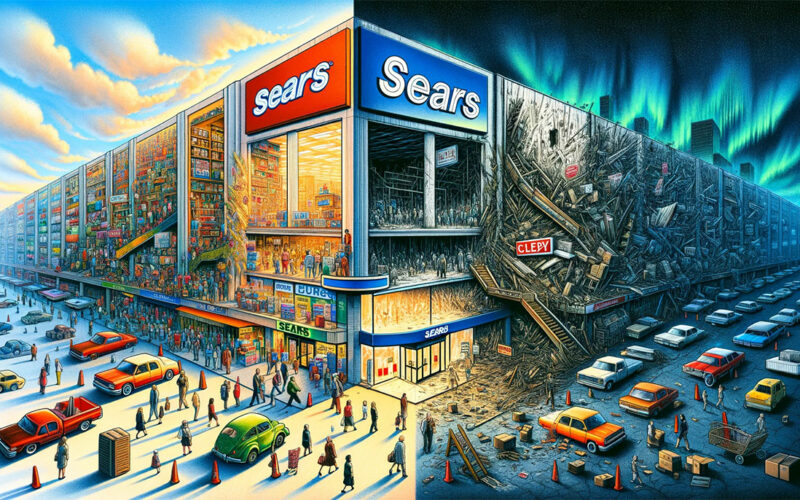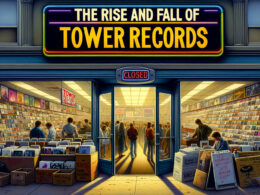From Retail Giant to Decline: What Happened to Sears?

Picture this: a world without online shopping, without malls at every corner. Back then, Sears wasn’t just a store; it was the store. Imagine needing a fridge, a pair of jeans, and some garden tools.
Back in the day, there was one answer to all that: Sears. It’s where America shopped. What happened to Sears? Stick with me; it’s a story of epic rises and falls.
It’s like we’re watching a movie where the hero is on top of the world, and then, scene by scene, things start to unravel. Sears’ story is kinda like that. There was a time when Sears was the backdrop of the American dream, with its catalogs in every home and its stores in every neighborhood.
This was the place you went for everything. But here’s the thing: the retail landscape started changing, and fast. Other names started popping up, and the internet? That was a game-changer.
We all keep asking, what happened to Sears? It’s simple but also complex: they missed the bus while everyone else was catching the next retail express.
The Golden Years
Early Innovations and Expansion
The Sears Catalog and Mail-Order Business
Alright, picture this: It’s the late 1800s. No internet, no smartphones. If you’re living out in the sticks and need a plow or a petticoat, you’re out of luck, right?
Wrong.
Because here comes the Sears catalog, dropping a world of products right in your lap. It was revolutionary. The Amazon of its day, as The New York Times calls it.
What happened to Sears? It started out as this juggernaut that brought city-store convenience to rural America with just a postage stamp.
Retail Revolution and Suburban Focus
Then the suburbs started booming. People were moving out of the cities, looking for that white picket fence life. Sears caught the vibe.
They shifted from catalog to brick-and-mortar, popping up in the ‘burbs where the action was. It was like a retail revolution, with Sears at the helm, turning shopping into an experience.
Iconic Developments
Construction of the Sears Tower
Now let’s hit the skyline. The Sears Tower shot up in Chicago, and suddenly Sears wasn’t just a store; it was an icon.
That tower wasn’t just about office space; it was a statement. “We’re Sears, and we’re not just selling clothes and tools—we’re building America.”
Diversification into Financial Services
And then, hold up—Sears wasn’t satisfied with just selling you stuff; they wanted to handle your money, too.
They started diversifying, dipping their toes into areas like financial services.
Picture getting your insurance, your credit card, even your investments, all under the same roof as your washing machine and your lawnmower.
The Turning Point
Changing Consumer Habits
Shift in Business Dynamics
You know that moment in a movie where everything changes? That’s the scene we’re at. It’s all about vibes, and the vibes were changing.
People weren’t just buying stuff; they were looking for experiences, a bang for their buck, something new. And here’s Sears, kinda stuck in the past, not catching up with this new wave.
People started looking online, chasing the convenience, and here’s Sears, lagging behind, clinging to old-school tactics.
The world’s buzzing with e-commerce and digital window-shopping, and Sears? It was like watching someone trying to catch a bullet train on a bicycle.
Competition from Discount Retailers
Then enter the big guns, the discount retailers, rolling back prices and changing the game. They’re like the cool new kids, drawing in crowds with deals and steals.
What happened to Sears? It’s getting squeezed, like caught between a rock and a hard place.
These discount giants are pulling up with shopping carts full of savings, and Sears is there, its prices looking a little… tired.
Strategic Missteps
Discontinuation of the Catalog
Here’s the kicker, though. Remember the Sears catalog? That big book of dreams? Yeah, they shelved it. Cut it off like it was nothing.
This wasn’t just a book; it was a piece of Americana, and when they ditched it, it was like they ditched their magic. What happened to Sears? It lost a chunk of its soul, and that’s not something you just find lying around.
Merger with Kmart
And if that wasn’t enough, Sears goes and ties the knot with Kmart. Sounds like a power move, right?
Wrong.
It’s like mixing water and oil, and expecting a smoothie.
Both were struggling, and instead of a comeback story, it was more like two sinking ships trying to save each other, but not in a romantic way.
The Downward Spiral

Failure to Innovate
Lack of Investment in E-commerce
So we’re in the digital age, right? And if you’re not online, you’re practically invisible. Sears’ online presence was like a whisper in a thunderstorm.
People are clicking and buying, scrolling and shopping, and Sears? It’s chilling in the back, not getting with the program.
No fresh online stores, no digital marketing. Just a big old silence in the e-commerce chorus.
Missed Opportunities in Retail Trends
It’s not just about being online, it’s about riding the wave, keeping up with what’s hot. The trends are like fireflies, man, you gotta catch ’em fast.
But Sears? It missed those retail trend fireflies. It’s like showing up at a costume party… without the costume.
Declining Store Experience
Underinvestment in Store Upgrades
Walking into a Sears store started feeling like a blast from the past, and not in a cool, retro way.
More like, “Wow, nothing’s changed since my grandma shopped here.” No fresh paint, no modern touch. It’s tough to get excited about shopping in a place that feels forgotten by time.
Negative Feedback Loop and Brand Stagnation
And with the stores feeling all old and tired, people started talking. And not the good kind of talk.
This feedback wasn’t rave reviews; it was more like, “Why bother with Sears?” And this talk starts feeding itself, right? It’s a loop, a downward spiral, and suddenly Sears isn’t just a store; it’s a symbol of what used to be.
The Final Struggle
Inventory and Supply Chain Issues
Poor Inventory Management
So here’s the scene: shelves are looking sparse, the stuff people want is MIA, and the stuff nobody’s buying is just gathering dust.
That’s the kind of inventory mess Sears got tangled up in. It’s like throwing a party and forgetting to stock up on snacks.
What happened to Sears? Well, part of it was this whole deal of not knowing what to keep on the shelves. Customers would bounce in, looking for the hot new thing, and find nothing but last season’s leftovers.
Supplier Concerns and Cutbacks
And the plot thickens, right? Suppliers are side-eyeing Sears, worrying about getting their cut.
They start holding back, shipping fewer goodies because they’re not sure if Sears is good for it. It’s a trust fall gone wrong. Suppliers are supposed to catch you, but instead, they’re stepping back, hands up, not wanting to go down with the ship.
Financial Troubles
Revenue Decline and Store Closures
Cash is king, but Sears’ crown is slipping. The dough isn’t rolling in like before, and that’s a big uh-oh.
Stores start shutting down, one after the other, lights out, doors locked. Each closed store is like a ghost, a reminder of what used to be bustling with shoppers.
What happened to Sears? It’s running out of steam, and the revenue just isn’t there to keep things chugging along.
Bankruptcy and Legal Challenges
Then boom, the B-word hits: bankruptcy. It’s like a storm cloud that’s been brewing, and now it’s pouring hard.
Legal battles are no fun, they’re like quicksand for any business. And Sears? It’s knee-deep, trying to find solid ground while papers are being shuffled in courtrooms.
Key Factors Behind the Downfall
Mall Anchor Locations and Decline
Malls used to be the it-spot, the place to hang, shop, and eat a giant pretzel. Sears was the anchor, the big draw.
But then malls start to crumble, like sandcastles at high tide. Online shopping is the new hangout, and Sears is left holding the bag, still standing in the emptying halls of once-thriving malls.
Unclear Value Proposition
It’s all about standing out, right? But Sears starts blending into the background, like camo in the woods.
The deal they’re offering isn’t sweet enough or clear enough. People are scratching their heads, wondering, what happened to Sears? Why shop there when you can get the same stuff, but cheaper or faster, somewhere else?
Loss of Customer Data Advantage
Data’s the new gold, and Sears had a mine of it. But did they use it? Not really. They had the scoop on what people bought, when they bought it, how they liked to shop.
But instead of using that gold to make things better, they kinda just sat on it. Other stores are getting personal, all “Hey, we know what you like,” while Sears is still sending out generic “Hey, you might like this” vibes.
Inability to Adapt to Competitive Threats
You gotta stay on your toes, always ready to dance to the next tune. But Sears? It’s got two left feet when it comes to keeping up with the competition.
New brands are sprinting, tech is flipping the script, and here’s Sears, not changing its step. It’s like they’re trying to do the moonwalk while everyone else is doing the floss.
FAQ On What Happened To Sears
Why Did Sears Go Under?
Let me break it down for you. Sears, once the kingpin of retail, had its crown toppled by a combo of stiff competition and a failure to stay on the ball with digital trends.
They didn’t just miss the e-commerce bus; they watched it speed by while chilling at the bus stop. It’s like they kept playing checkers while the whole world moved on to 3D chess. They didn’t pivot or hustle to keep up with the times, and that’s the gist of it.
What Led to the Downfall of Sears?
You know how sometimes you just can’t see the forest for the trees? That was Sears with its colossal stores. They stuck to their big guns while the retail war changed to guerrilla tactics. Nimbler, savvier players like Amazon and Walmart rewrote the playbook, and Sears… well, they barely changed the page.
Plus, let’s not forget their financial misadventures and that whole merger fiasco with Kmart that tied two sinking ships together.
How Did Online Shopping Impact Sears?
Oh, buddy, it was like a sledgehammer to a soufflé. Online shopping is the Goliath that Sears never really fought. They underestimated the power of a click versus a step.
While everyone else was building their online empire, Sears was still banking on folks wanting to wander their aisles. The internet became the shopping mall of the world, and Sears was still handing out physical maps.
Wasn’t Sears Once the Largest Retailer?
Absolutely, they were the Goliath in the ring. Imagine a time when the Sears catalog was the Amazon of the day. Anything you needed, from socks to houses, yep, houses, you’d get it from Sears.
They were the blueprint of retail innovation. But just like in those Greek tragedies, the mighty have a way of tumbling when they stop looking ahead. Resting on laurels isn’t a great game plan, turns out.
Why Didn’t Sears Adapt to New Retail Trends?
Picture this: Sears was like that band that has one hit wonder and keeps playing it at every show. They saw the retail trends changing, the tunes evolving, but they didn’t learn the new songs.
Their stores became time capsules in a world that was racing ahead. When the retail script flipped to e-commerce and experiential shopping, Sears was still rehearsing its old lines.
What Role Did the Sears Catalog Play?
The Sears catalog was like the magic carpet of shopping, taking folks on a ride through a world of goods from the comfort of their own homes. It was revolutionary.
But here’s the kicker: when the digital revolution came knocking, Sears ditched the catalog instead of reinventing it online. It’s like they had the secret sauce but decided to toss it out just when the dish needed it the most.
Could Sears Have Competed with Amazon?
Competed? Sure. But it’s like they were in a foot race wearing lead boots. Amazon sprinted forward with technology, customer data, and a hunger to be everywhere at once.
Sears? They were ambling along, seemingly unaware of the race’s pace. With investment in e-commerce and a radical strategy shake-up, they could’ve been a contender, but they needed to wake up and smell the algorithm.
What’s the Status of Sears Now?
Well, picture a once-majestic oak now just clinging to life. There are still some Sears stores out there, echoes of the past. They’re like those little indie movies that get a limited release.
The company’s still breathing, but it’s a wheeze rather than a roar. It’s a chapter of retail history now, serving as a cautionary tale more than a shopping destination.
Did the Sears-Kmart Merger Affect Its Downfall?
Oh, for sure. That merger was supposed to be a power move, but it was more like tying two bricks together and hoping they’d float. Both brands were struggling, and instead of reinventing themselves, they doubled down on outdated tactics.
It’s a classic case of two negatives not making a positive. The merger drained resources, muddled the brand identity, and just accelerated the downfall.
What Lessons Can Be Learned from Sears’ Story?
If Sears’ story was a book, it’d be mandatory reading for every business student. Lesson one: Adapt or get left behind. Ignoring the digital wave and the shifting sands of customer desires is like ignoring gravity – not a great idea.
Lesson two: Big doesn’t always mean invincible. Stay hungry, stay foolish, right? And finally, know when to pivot, because loyalty to a failing strategy is just a sinking ship.
Conclusion On What Happened To Sears
Alright, let’s get down to the nitty-gritty. We’ve all been eyeballing the slow-motion fall of a once-mighty giant and asking ourselves, what happened to Sears? It’s like watching a ship that’s been adrift and finally goes under. Here’s the takeaway, the lessons we’ve gotta pocket from this saga:
First off, if your inventory is as outdated as a flip phone and you’re not syncing with what folks want, that’s a no-go. Sears’ slip showed here big time. Then, let’s talk tech. E-commerce is the big league, and if you’re not playing ball there, you’re striking out. Sears missed that swing.
Don’t even get me started on vibes – store vibes. You walk into a place that looks like a throwback to the ’90s, and not in a cool, retro way? Yeah, that’s not gonna fly. Sears’ store atmosphere was like that – it didn’t just need a facelift; it needed a whole new identity.
And it’s not just about keeping up; it’s about leading the charge. Innovation isn’t just a fancy buzzword; it’s the secret sauce. Sears kind of forgot the recipe here. They had the tools – customer data, a legacy of trust – but they let it collect dust.
If you liked this article about what happened to Sears, you should check out this article about what happened to MoviePass.
There are also similar articles discussing what happened to Quiznos, what happened to Pan Am, what happened to BlackBerry, and what happened to Pontiac.
And let’s not forget about articles on what happened to Circuit City, what happened to American Apparel, startup failure, and failed startups.
- Simplifying Video Editing: Creative Apps Like Kapwing - May 3, 2024
- Healthcare software: Exploring 10 essential types and their benefits - May 3, 2024
- The Best CSS Preprocessors for Developers - May 3, 2024








